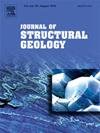水星上缩短地貌下逆冲系统的几何正演模拟
IF 2.9
2区 地球科学
Q2 GEOSCIENCES, MULTIDISCIPLINARY
引用次数: 0
摘要
水星上有成千上万的缩短地貌分布在整个星球上。人们普遍认为,这种缩短是由逆冲断层和褶皱共同作用造成的,这是由长期持续的冷却造成的水星的全球收缩造成的。水星表面的大多数缩短地貌被分为两类:叶状陡坡或皱状山脊。这些缩短地貌分类在地表形态上没有明显的统计差异。只有一小部分缩短地貌是明确末端褶皱脊和裂片陡崖。缩短地貌的地貌表现之间的差异可能完全由冲断体系和形成它们的相关褶皱决定。因此,我们模拟了与水星表面发现的55个叶状陡坡和褶皱脊端部缩短地貌相关的推力系统。构造在构造起伏最大的地貌的地形剖面下方的二维剖面中建模。模型采用MOVE地质建模软件中的断层弯曲褶皱算法。一旦模型与观测到的地形和缩短应变相匹配,就可以提取并编制所有构造的断层几何参数,如构造数量、倾角、断裂深度、断裂程度、高度等。我们的模型显示,水星拥有多种复杂的逆冲系统,包括单一、表状断层、叠瓦状逆冲和弹出式构造。特别是,叶状陡坡端部结构的形态最好用单一的片状断层模型来解释,而大多数皱脊端部结构需要一个以上的断层。我们发现褶皱脊和叶状陡崖原型的断层几何参数变化有很大的重叠,证实了我们之前的地貌分析结果,即缩短地貌不包括两个不同的类别。几何参数的重叠表明,叶状陡坡和皱状脊端部结构的形成机制是相同的。本文章由计算机程序翻译,如有差异,请以英文原文为准。
Geometric forward modeling of thrust systems underlying shortening landforms on Mercury
Mercury hosts thousands of shortening landforms that are widespread across the entire planet. The shortening is widely accepted to be caused by a combination of thrust faulting and folding, resulting from the global contraction of Mercury caused by long, sustained cooling. Most shortening landforms on Mercury's surface have been classified into one of two groups: lobate scarps or wrinkle ridges. There is no distinct statistical difference in the surface morphology of these shortening landform classifications. Only a small subset of shortening landforms are clear-endmember wrinkle ridges and lobate scarps. The difference between geomorphic manifestations of shortening landforms may be governed entirely by the thrust systems and associated folding that form them. We therefore model thrust systems associated with 55 lobate scarp and wrinkle ridge endmember shortening landforms found across the surface of Mercury. Structures were modeled in 2D sections below the topographic profiles of landforms with the greatest structural relief. Models utilized the fault-bend fold algorithm in the MOVE geologic modeling software. Once models matched the observed topography and shortening strain, fault geometric parameters, such as number of structures, dip, depth extent of faulting, height, etc., were extracted and compiled for all structures. Our modeling shows that Mercury hosts a wide range of complex thrust systems, including single, listric faults, imbricate thrusts, and pop-up structures. In particular, the morphologies of lobate scarps endmember structures are best explained by models of a single, listric fault, whereas most wrinkle ridge endmember structures require more than one fault. We identify a large overlap in the variation of fault geometric parameters for both wrinkle ridge and lobate scarp archetypes, confirming the results of our previous geomorphic analysis that shortening landforms do not comprise two distinct categories. The overlap in geometric parameters suggests that the formation mechanisms of lobate scarp and wrinkle ridge endmember structures are the same.
求助全文
通过发布文献求助,成功后即可免费获取论文全文。
去求助
来源期刊

Journal of Structural Geology
地学-地球科学综合
CiteScore
6.00
自引率
19.40%
发文量
192
审稿时长
15.7 weeks
期刊介绍:
The Journal of Structural Geology publishes process-oriented investigations about structural geology using appropriate combinations of analog and digital field data, seismic reflection data, satellite-derived data, geometric analysis, kinematic analysis, laboratory experiments, computer visualizations, and analogue or numerical modelling on all scales. Contributions are encouraged to draw perspectives from rheology, rock mechanics, geophysics,metamorphism, sedimentology, petroleum geology, economic geology, geodynamics, planetary geology, tectonics and neotectonics to provide a more powerful understanding of deformation processes and systems. Given the visual nature of the discipline, supplementary materials that portray the data and analysis in 3-D or quasi 3-D manners, including the use of videos, and/or graphical abstracts can significantly strengthen the impact of contributions.
 求助内容:
求助内容: 应助结果提醒方式:
应助结果提醒方式:


